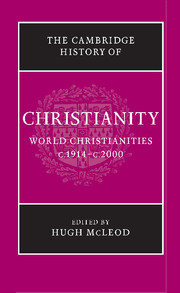Book contents
- Frontmatter
- 1 Introduction
- 2 Being a Christian in the early twentieth century
- PART I INSTITUTIONS AND MOVEMENTS
- PART II NARRATIVES OF CHANGE
- 8 The Great War
- 9 The Christian churches and politics in Europe, 1914–1939
- 10 Latin America, c.1914–c.1950
- 11 African Christianity: from the world wars to decolonisation
- 12 The African diaspora in the Caribbean and Europe from pre-emancipation to the present day
- 13 Christianity in the United States during the inter-war years
- 14 Christian churches in Australia, New Zealand and the Pacific, 1914–1970
- 15 Catholicism and Protestantism in the Second World War in Europe
- 16 The Cold War, the hegemony of the United States and the golden age of Christian democracy
- 17 The religious ferment of the sixties
- 18 The crisis of Christianity in the West: etering a post-Christian era?
- 19 The revolutions in eastern Europe and the beginnings of the post-communist era
- 20 The transformation of Latin American Christianity, c.1950–2000
- 21 Religion and racism: struggles around segregation, ‘Jim Crow’ and apartheid
- 22 Post-colonial Christianity in Africa
- 23 South Asia, 1911–2003
- 24 Christianity in South-East Asia, 1914–2000
- 25 East Asia
- PART III SOCIAL AND CULTURAL IMPACT
- Bibliography
- Index
- References
9 - The Christian churches and politics in Europe, 1914–1939
from PART II - NARRATIVES OF CHANGE
Published online by Cambridge University Press: 28 March 2008
- Frontmatter
- 1 Introduction
- 2 Being a Christian in the early twentieth century
- PART I INSTITUTIONS AND MOVEMENTS
- PART II NARRATIVES OF CHANGE
- 8 The Great War
- 9 The Christian churches and politics in Europe, 1914–1939
- 10 Latin America, c.1914–c.1950
- 11 African Christianity: from the world wars to decolonisation
- 12 The African diaspora in the Caribbean and Europe from pre-emancipation to the present day
- 13 Christianity in the United States during the inter-war years
- 14 Christian churches in Australia, New Zealand and the Pacific, 1914–1970
- 15 Catholicism and Protestantism in the Second World War in Europe
- 16 The Cold War, the hegemony of the United States and the golden age of Christian democracy
- 17 The religious ferment of the sixties
- 18 The crisis of Christianity in the West: etering a post-Christian era?
- 19 The revolutions in eastern Europe and the beginnings of the post-communist era
- 20 The transformation of Latin American Christianity, c.1950–2000
- 21 Religion and racism: struggles around segregation, ‘Jim Crow’ and apartheid
- 22 Post-colonial Christianity in Africa
- 23 South Asia, 1911–2003
- 24 Christianity in South-East Asia, 1914–2000
- 25 East Asia
- PART III SOCIAL AND CULTURAL IMPACT
- Bibliography
- Index
- References
Summary
Any survey of the power and influence of the Christian churches in Europe undertaken in the summer of 1939 would have been largely pessimistic. Be it in the few remaining parliamentary regimes of Europe or the heterogeneous and increasing number of authoritarian, quasi-authoritarian or simply dictatorial regimes that were becoming the new European norm, the influence of the Christian churches, political parties and values appeared to have receded considerably over the twenty-five years since the outbreak of the First World War. Socialism, still rooted in much of Europe in the anti-clerical culture of its nineteenth-century origins, had become a major electoral force and an intermittent party of government in many states. In addition, its fission after the First World War had given rise to a militantly atheist communism which, despite its repeated failure to extend its power in Europe beyond the frontiers of the Soviet Union, had established itself by the 1930s as a durable and, in some areas, important presence in European politics. Undoubtedly the most dramatic trend, however, was the emergence of forms of right-wing politics separate from or even emphatically hostile to Christian ideas. Though elements of this ‘dechristianisation’ of the political right had been evident since at least themiddle decades of the nineteenth century, it acquired emphatic importance after the First World War. Italian Fascism and German-Austrian Nazism were dissimilar and profoundly unstable amalgams of diverse ideological influences, within which Christian ideas, both Catholic and (in the case of Germany) Protestant in origin, had a significant presence.
- Type
- Chapter
- Information
- The Cambridge History of Christianity , pp. 151 - 178Publisher: Cambridge University PressPrint publication year: 2006
References
- 3
- Cited by



